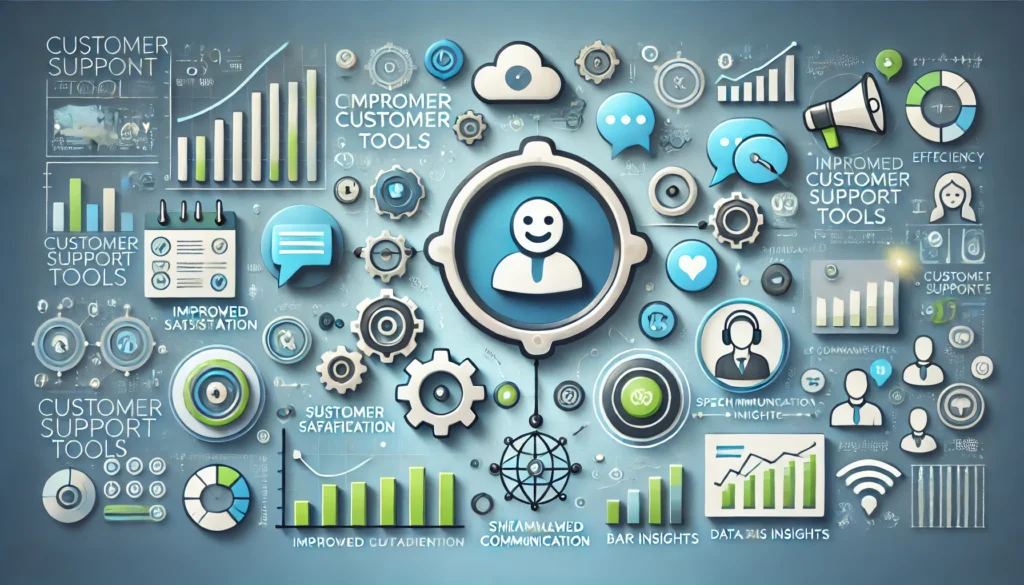Customer Support Tools
Let’s be real: great customer support can make or break a business. You know that one time you called a company for help, and it felt like pulling teeth just to get a straight answer? Frustrating, right? Now imagine being on the other side of that equation—a business trying to juggle hundreds of similar customer requests every single day.
That’s where customer support tools come in to save the day. They’re like your support team’s trusty sidekick, always ready to organize, streamline, and simplify the chaos. With the right tools, you can turn frustrating experiences into moments that make your customers go, “Wow, that was easy!”
Whether you’re managing a small team or a full-scale call center, having the best tools in your arsenal can help you respond faster, fix problems more efficiently, and keep your customers smiling. Ready to explore how? Let’s dive into the world of customer support tools and see what they can do for you.
Why Are Customer Support Tools Essential?
Imagine a scenario where your support team juggles multiple customer queries without a system in place. Chaos, right? Here’s why customer support tools are indispensable:
- Enhanced Efficiency: Automate repetitive tasks, like ticket assignments and follow-ups.
- Improved Accuracy: Centralized data reduces errors and ensures consistent responses.
- Customer Satisfaction: Quicker response times lead to happier customers.
- Scalability: Easily manage growing volumes of queries as your business expands.
From ensuring timely responses to delivering personalized customer experiences, these tools are game-changers for modern businesses.
Top Features to Look for in Customer Support Tools
Not all tools are created equal. The right customer support tool should have the following features:
- Omnichannel Support: Integrate email, chat, social media, and phone into a unified platform.
- Automation Capabilities: Use AI-powered chatbots and automated ticket routing to save time.
- Customizable Dashboards: Track key performance metrics in real time.
- Collaborative Tools: Enable seamless communication between team members.
- Integration Options: Sync with existing CRMs and third-party apps for a cohesive workflow.
Investing in tools with these features will set your team up for success.
Types of Customer Support Tools
1. Help Desk Software
Help desk tools are the backbone of customer support. They centralize all customer queries, categorize them into tickets, and track resolution statuses. Popular choices include Zendesk and Freshdesk.
2. Live Chat Tools
Live chat tools like Intercom and LiveChat offer real-time communication, helping customers get instant answers.
3. Knowledge Bases
A self-service knowledge base tool like HelpJuice lets businesses create detailed guides and FAQs for customers to solve issues independently.
4. CRM Systems
Customer Relationship Management (CRM) tools, such as Salesforce or HubSpot, keep all customer data organized for personalized service.
5. Social Media Monitoring Tools
Tools like Hootsuite help businesses monitor and respond to customer queries on social platforms swiftly.
Best Customer Support Tools
1. Zendesk
- Features: Omnichannel support, AI-powered bots, robust analytics.
- Best For: Enterprises needing scalability.
2. Freshdesk
- Features: Affordable pricing, customizable workflows, mobile app support.
- Best For: Small to medium businesses.
3. Intercom
- Features: Live chat, proactive messaging, powerful integrations.
- Best For: Startups aiming for real-time engagement.
4. HubSpot Service Hub
- Features: CRM integration, ticket automation, and customer feedback tools.
- Best For: Businesses seeking all-in-one solutions.
5. Tidio
- Features: Live chat, chatbot builder, multilingual support.
- Best For: E-commerce businesses.
Benefits of Using Customer Support Tools

- Faster Response Times: Tools reduce delays by routing queries to the right agents.
- Improved Team Collaboration: Shared dashboards and notes ensure no query falls through the cracks.
- Cost-Effectiveness: Automation reduces the need for additional staffing.
- Data-Driven Insights: Analytics help identify trends and areas of improvement.
How to Choose the Right Tool for Your Business
Choosing the right customer support tool can feel like finding a needle in a haystack, but with a clear strategy, you can make the perfect choice. Here’s a step-by-step guide to help:
1. Assess Your Needs
- Do you need a tool for live chat, ticketing, or social media support?
- How many agents will use the software?
- What channels do your customers use most frequently?
2. Define Your Budget
Customer support tools range from free basic versions to premium enterprise-grade solutions. Know your financial limits before exploring options.
3. Prioritize Features
Look for tools with must-have features like AI integration, analytics dashboards, or CRM compatibility. Avoid paying for unnecessary bells and whistles.
4. Test Drive Options
Take advantage of free trials and demos. Tools like Freshdesk and Zendesk often offer 14-day trials, letting you explore their functionalities firsthand.
5. Get Feedback from Your Team
Your agents will be the ones using these tools daily, so involve them in the decision-making process to ensure usability and comfort.
Key Trends in Customer Support Tools
The customer support landscape is constantly evolving, and staying ahead of trends can give your business a competitive edge.
1. AI and Machine Learning
AI chatbots and machine learning algorithms are revolutionizing customer support by predicting customer needs and automating routine tasks.
2. Omnichannel Support
Customers expect seamless experiences across multiple platforms, making omnichannel support tools indispensable.
3. Real-Time Data Analytics
Advanced analytics dashboards now offer real-time insights into agent performance and customer satisfaction.
4. Personalization at Scale
Tools are increasingly leveraging customer data to deliver hyper-personalized support.
5. Integration-First Solutions
Modern support tools prioritize compatibility with CRMs, marketing platforms, and productivity apps for a unified workflow.
Integrating Customer Support Tools into Your Workflow
Implementing customer support tools isn’t just about purchasing software—it’s about seamlessly embedding them into your operations. Here’s how:
1. Train Your Team
Comprehensive training ensures that your agents know how to use the tool’s features effectively.
2. Start with Core Functions
Focus on core functionalities like ticket management or live chat before exploring advanced options like analytics or integrations.
3. Monitor Performance
Use the tool’s reporting features to track response times, resolution rates, and customer satisfaction levels.
4. Seek Customer Feedback
Regularly solicit feedback to refine your approach and identify any tool-related pain points.
Common Challenges and How to Overcome Them
1. Adoption Resistance
Some team members may be hesitant to adopt new tools. Overcome this by emphasizing the tool’s benefits and providing hands-on training.
2. Tool Overload
Too many tools can overwhelm your team. Stick to a few versatile solutions that cover multiple needs.
3. Cost Management
Expensive tools can strain budgets. Explore affordable alternatives or consider tiered pricing plans.
4. Integration Hiccups
Ensure your chosen tool integrates smoothly with existing systems by consulting with IT professionals before purchase.
Cost Analysis: Free vs. Paid Tools
Free tools like HubSpot’s basic service hub can be a great starting point for small businesses, but they often lack advanced features. Paid options like Zendesk or Intercom offer scalability, automation, and advanced analytics—perfect for growing enterprises.
When to Choose Free Tools
- Limited budget
- Small customer base
- Simple workflows
When to Invest in Paid Solutions
- High query volumes
- Need for advanced features like AI or automation
- Aiming for omnichannel support
Customer Support Tools for Small Businesses
Small businesses often operate on tight budgets but can still leverage cost-effective solutions to deliver exceptional support.
Top Picks for Small Businesses:
- Tidio: Affordable and easy to use.
- Zoho Desk: Scalable with a free plan.
- LiveAgent: Comprehensive support at low prices.
With these tools, small businesses can punch above their weight and compete with larger firms.
Enterprise-Grade Customer Support Solutions
For larger organizations, robust tools with extensive capabilities are a must.
Recommended Solutions:
- Salesforce Service Cloud: Seamlessly integrates with CRM for a 360-degree customer view.
- Zendesk Suite: Offers omnichannel support with advanced analytics.
- Oracle Service Cloud: Designed for large-scale customer service operations.
These solutions ensure scalability and efficiency, even for enterprises handling millions of customer interactions annually.
Success Stories: Businesses Revolutionized by Support Tools
1. Shopify
By integrating Zendesk, Shopify reduced response times by 50%, improving customer satisfaction dramatically.
2. Airbnb
Using Intercom, Airbnb created personalized customer experiences, boosting user retention.
3. Buffer
With the help of HelpScout, Buffer streamlined support operations, allowing their small team to handle a growing user base effectively.
Conclusion
Customer support tools aren’t just a convenience; they’re a necessity for modern businesses. From live chat to CRM systems, the right tools can elevate your customer service, boost satisfaction, and streamline operations. Whether you’re a small business or an enterprise, there’s a solution tailored to your needs.
FAQs
1. What is the best customer support tool for small businesses?
Tidio, Zoho Desk, and LiveAgent are excellent options for small businesses due to their affordability and ease of use.
2. Can customer support tools integrate with existing software?
Yes, most modern tools integrate seamlessly with CRMs, marketing platforms, and other business software.
3. Are free customer support tools reliable?
Free tools like HubSpot’s service hub can be effective for small businesses but often lack the advanced features required for scalability.
4. What features should I prioritize in a customer support tool?
Focus on omnichannel support, automation, analytics, and integration capabilities.
5. How do I measure the success of a customer support tool?
Track metrics like response times, resolution rates, and customer satisfaction scores to gauge effectiveness.


